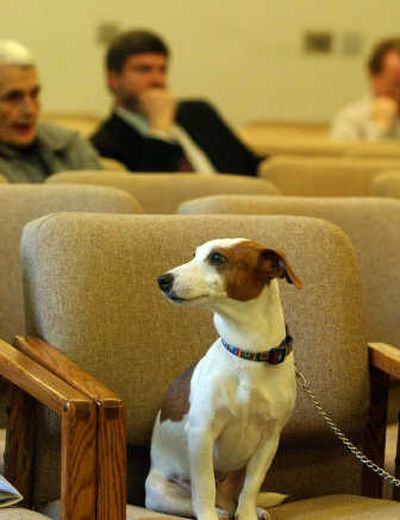Bill broadens cougar hunting

OLYMPIA – State Rep. Joel Kretz’s slideshow came with a warning.
“There are some graphic pictures in here,” he told state lawmakers at a recent hearing.
Up came a photo of one of the Okanogan County lawmaker’s colts, with pink, exposed flesh on its flanks from gashes on both sides. Next was his son’s saddle horse, a 1,200-pound animal, with similar injuries.
“But here’s what I think we all better be watching for,” Kretz continued as the next photo showed a young boy in a hospital, dotted with cuts, gashes and puncture wounds.
Twelve years after Washington residents voted overwhelmingly to sharply limit the hunting of cougars and black bears with the aid of dogs, Kretz wants to expand a recent cougar-control program in a few rural counties to other parts of the state and make it permanent.
Critics say the change would gut the ballot measure, which was approved 63 percent to 37 percent.
“We believe this bill is contrary to the will of Washington voters,” Inga Gibson, with the Humane Society of the United States, told lawmakers. Under Kretz’ proposal, she said, “cougars with no known history of conflict could be indiscriminately killed.”
Gibson was blasted by some of the Eastern Washington ranchers who showed up to support for the proposal.
“She sits in an office somewhere, clapping her hands and saying we should leave the cougar alone,” said former Okanogan County Commissioner Ed Thiele, describing livestock predation on his brother-in-law’s ranch. “Let her come out and see what is happening out there in the real world.”
Shortly after the initiative passed, cougar complaints confirmed by the state Department of Fish and Wildlife rose from 495 incidents in 1996 to about 930 in 1998 and 2000. In response, the state boosted the cougar-hunting season – without using dogs – from 3 months to 7 ½ and sold tens of thousands more tags to people who wanted to hunt the cats.
The bag limit increased from one to two cougars a year. The cost of a tag was dropped from $24 to $5. It’s since increased to about $10 – still cheaper than a deer tag.
The number of cougars killed rose from about 156 a year statewide to 195 in the years immediately after the law took effect.
But the cats that got shot were typically stumbled across while hunters were pursuing other game; they weren’t necessarily problem cougars. They also tended to be female cats and young cats instead of older males. Here’s why: Hunters whose dogs tree a cat can be more selective, looking over the trapped cougar before deciding whether to kill it.
By 2000, lawmakers allowed limited use of dogs to hunt and tree documented problem cougars for shooting. In 2004, they eased the restrictions, setting up a temporary pilot program allowing licensed hunters to use dogs to hunt problem cougars in five counties: Ferry, Stevens, Pend Oreille, Okanogan and Chelan. By 2006, the number of confirmed cougar complaints was 323, according to a 2008 legislative report by Fish and Wildlife.
Kretz’s bill would make the pilot program permanent. It would also allow any other county to ask the state to let it join the program.
“Legislators have dressed H.B. 2438 up to make it look like the proposal is about ‘managing’ problem cougars,” Brian Vincent, a spokesman for the British Columbia-based group Big Wildlife, said in a statement. “But no matter how much lipstick lawmakers put on this bill, it will be the kiss of death for cougars in the state.”
He called the proposal “a gift to trophy hunters who are still whining about Initiative 655.”
In their report to lawmakers, state officials said “the use of dogs is a valuable and needed component of an effective cougar management program.”
It’s impractical to try to fence in the cougars or relocate them. It’s difficult to reduce prey – like deer or elk – enough to get cougars to leave.
The only non-lethal thing that seems to work to date, they say, is public education: bumper stickers, refrigerator magnets and school classes. Wildlife managers try to convince people to change their habits so cougars aren’t drawn into residential areas.
Even hunting with dogs may be impractical in many parts of Washington. Dry areas lack the snowfall that shows cougar tracks, for example. And hound hunting “is probably not socially acceptable in the Puget Sound lowland areas.”
Even in the test counties, it’s unclear how well the pilot project is working. A 2006 Washington State University study said “Contrary to accepted belief, our findings suggest that cougars in the Pacific Northwest are currently declining.” It recommended less hunting, particularly for adult female cats.
A second WSU study theorized that hunting in the five-county region may create “an attractive sink” drawing in neighboring young cougars in search of food-rich habitat.
It’s also unclear, the state Fish and Wildlife Department says, whether chasing cougars with dogs scares them into staying away. Harassing black bears has been shown to work when they’re scavenging for human food and there’s a clear link between the behavior and electric shock, non-lethal projectiles or dogs.
But “randomly” harassing cougars with dogs may not work, the department says. In a small test on cougars with radio collars, it said, the cougars didn’t move even after pursued by dogs.
At the hearing in Olympia, proponents’ Exhibit A was a 7-year-old Jack Russell terrier named Tray. Owner Lee Barker, a disabled Omak trucker, believes that four neatly-spaced puncture wounds on the dog’s back came from the swipe of a cougar’s paw.
Madonna Luers, a spokeswoman for Fish and Wildlife, declined to speculate on the likelihood of a tiny dog in a pasture escaping a cougar, saying, “Frankly, we never say never about anything with wildlife.”
“We need this,” Barker told lawmakers as Tray perched beside him in a chair. “This is rural America, supposedly, but it’s pretty dadgum urban for the cats to be getting in there.”